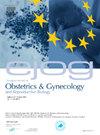The impact of serum homocysteine levels in women and men on pregnancy outcomes in fresh IVF/ICSI cycles: A retrospective cohort study
IF 2.1
4区 医学
Q2 OBSTETRICS & GYNECOLOGY
European journal of obstetrics, gynecology, and reproductive biology
Pub Date : 2025-03-24
DOI:10.1016/j.ejogrb.2025.03.038
引用次数: 0
Abstract
Background
High serum homocysteine (Hcy) levels are associated with reduced fertility and adverse pregnancy outcomes. Previous studies have produced inconsistent results regarding the influence of Hcy levels on in vitro fertilization (IVF) and intracytoplasmic sperm injection (ICSI) outcomes. Moreover, most existing studies have predominantly focused on Hcy levels in women, with limited attention given to serum Hcy levels in men.
Methods
This retrospective cohort study was conducted at the Reproductive Center of Xi’an People’s Hospital (Xi’an Fourth Hospital) from October 2021 to October 2023, involving a total of 481 patients who underwent fresh embryo transfer. Male and female patients were grouped according to quartiles of serum Hcy concentration. Of these, 290 patients achieved pregnancy, while 191 did not. Follow-up data showed that 250 patients maintained their pregnancies to 12 weeks, while 40 experienced early miscarriage. Pregnancy outcomes were analyzed for all patients and for clinically pregnant women who were followed up to 12 weeks, with a focus on factors associated with early miscarriage.
Results
The results demonstrated that the pregnancy rate with female serum Hcy concentrations ≥ 12.43 µmol/L was significantly lower than in those with Hcy concentrations < 8.07 µmol/L (P = 0.006) and 8.07–9.57 µmol/L (P = 0.008). Female serum Hcy ≥ 12.43 µmol/L was identified as an independent risk factor for early miscarriage (OR = 2.20, 95 % CI 1.24–3.88). No significant correlation was observed between female serum Hcy levels and embryo quality. Additionally, there was no significant association between male serum Hcy levels and clinical pregnancy, pregnancy outcomes, or embryo quality. Among the 250 cases of clinical pregnancy, 97.6 % (244 cases) resulted in successful live births, while 2.4 % (6 cases) did not result in live births. Non-live birth cases were primarily attributed to factors such as premature rupture of membranes, cervical insufficiency, oligohydramnios, fetal abnormalities, and other causes.
Conclusion
Elevated serum Hcy concentrations in women adversely affected clinical pregnancy and early miscarriage (≥12.43 µmol/L), while male serum Hcy did not show a significant effect. The inclusion of Hcy levels in both men and women provides a more comprehensive perspective for exploring multidimensional factors influencing fertility outcomes.
求助全文
约1分钟内获得全文
求助全文
来源期刊
CiteScore
4.60
自引率
3.80%
发文量
898
审稿时长
8.3 weeks
期刊介绍:
The European Journal of Obstetrics & Gynecology and Reproductive Biology is the leading general clinical journal covering the continent. It publishes peer reviewed original research articles, as well as a wide range of news, book reviews, biographical, historical and educational articles and a lively correspondence section. Fields covered include obstetrics, prenatal diagnosis, maternal-fetal medicine, perinatology, general gynecology, gynecologic oncology, uro-gynecology, reproductive medicine, infertility, reproductive endocrinology, sexual medicine and reproductive ethics. The European Journal of Obstetrics & Gynecology and Reproductive Biology provides a forum for scientific and clinical professional communication in obstetrics and gynecology throughout Europe and the world.

 求助内容:
求助内容: 应助结果提醒方式:
应助结果提醒方式:


